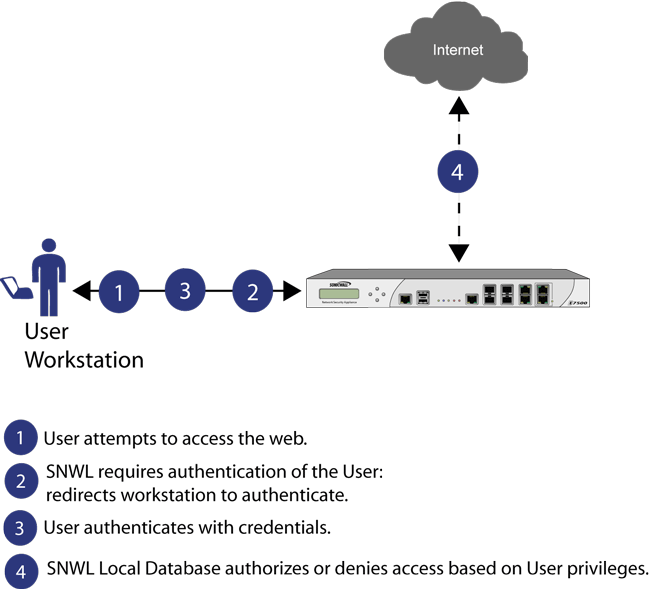
The SonicWall security appliance provides a local database for storing user and group information. You can configure the SonicWall appliance to use this local database to authenticate users and control their access to the network. Using Local Users and Groups for Authentication shows how The SonicWall appliance uses the local database for authentication.
Using Local Users and Groups for Authentication
To apply Content Filtering Service (CFS) policies to users, the users must be members of local groups and the CFS policies are then applied to the groups. To use CFS, you cannot use LDAP or RADIUS without combining that method with local authentication. When using the combined authentication method in order to use CFS policies, the local group names must be an exact match with the LDAP or RADIUS group names. When using the LDAP + Local Users authentication method, you can import the groups from the LDAP server into the local database on the SonicWall. This greatly simplifies the creation of matching groups, to which CFS policies can then be applied.
|
•
|
Group membership - Users can belong to one or more local groups. By default, all users belong to the groups Everyone and Trusted Users. You can remove these group memberships for a user, and can add memberships in other groups.
|
|
•
|
VPN access - You can configure the networks that are accessible to a VPN client started by this user. When configuring VPN access settings, you can select from a list of networks. The networks are designated by their Address Group or Address Object names.
|
You can also add or edit local groups. The configurable settings for groups include the following:
|
•
|
Group settings - For administrator groups, you can configure SonicOS to allow login to the management interface without activating the login status popup window.
|
|
•
|
Group members - Groups have members that can be local users or other local groups.
|
|
•
|
VPN access - VPN access for groups is configured in the same way as VPN access for users. You can configure the networks that are accessible to a VPN client started by a member of this group. When configuring VPN access settings, you can select from a list of networks. The networks are designated by their Address Group or Address Object names.
|
|
•
|
CFS policy - You can apply a content filtering (CFS) policy to group members. The CFS policy setting is only available if the SonicWall is currently licensed for Premium Content Filtering Service.
|